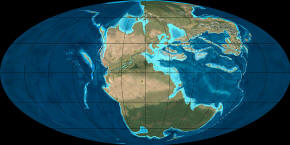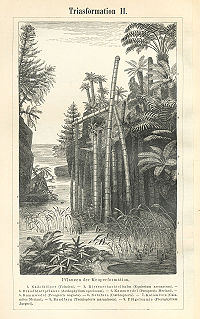The Triassic is usually separated into Early, Middle, and Late Triassic Epochs, and the corresponding rocks are referred to as Lower, Middle, or Upper Triassic.
Upper/Late Triassic - 203.6 ± 1.5 -228.0 ± 2.0 Ma
Middle Triassic - 228.0 ± 2.0 - 245.0 ± 1.5
Lower/Early Triassic - 251.0 ± 0.4 – 245.0 ± 1.5 Ma
Paleogeography
During the Triassic, almost all the Earth's land mass was concentrated into a single
 |
| Paleogeography during the Late Triassic, approximately 220 Ma (Picture Source) |
At the beginning of the Mesozoic Era, Africa was joined with Earth's other continents in Pangaea. Africa shared the supercontinent's relatively uniform fauna which was dominated by theropods, prosauropods and primitive ornithischians by the close of the Triassic period. Late Triassic fossils are found through-out Africa, but are more common in the south than north. The boundary separating the Triassic and Jurassic marks the advent of an extinction event with global impact, although African strata from this time period have not been thoroughly studied.
Climate
The Triassic climate was generally hot and dry, forming typical red bed sandstones and evaporites. There is no evidence of glaciation at or near either pole; in fact, the polar regions were apparently moist and temperate, a climate suitable for reptile-like creatures. Pangaea's large size limited the moderating effect of the global ocean; its continental climate was highly seasonal, with very hot summers and cold winters. It probably had strong, cross-equatorial monsoons.
Life
Three categories of organisms can be distinguished in the Triassic record:
holdovers from the Permian-Triassic extinction,
new groups which flourished briefly, and other new groups which went on to
dominate the Mesozoic world.
Flora
 |
| Triassic flora as depicted in Meyers Konversations-Lexikon (1885-90) |
On land, the holdover plants included the lycophytes, the dominant cycads, ginkgophyta (represented in modern times by Ginkgo biloba) and glossopterids. The spermatophytes, or seed plants came to dominate the terrestrial flora: in the northern hemisphere, conifers flourished. Glossopteris (a seed fern) was the dominant southern hemisphere tree during the Early Triassic period.
Marine fauna
In marine environments, new modern types of corals appeared in the Early Triassic, forming small patches of reefs of modest extent compared to the great reef systems of Devonian times or modern reefs. The shelled cephalopods called ammonites recovered, diversifying from a single line that survived the Permian extinction. The fish fauna was remarkably uniform, reflecting the fact that very few families survived the Permian extinction. There were also many types of marine reptiles. These included the Sauropterygia, which featured pachypleurosaurs and nothosaurs (both common during the Middle Triassic, especially in the Tethys region), placodonts, and the first plesiosaurs; the first of the lizardlike Thalattosauria (askeptosaurs); and the highly successful ichthyosaurs, which appeared in Early Triassic seas and soon diversified, some eventually developing to huge size during the late Triassic.
Terrestrial fauna
Reconstruction of
Proterosuchus, a genus
of carnivorous reptile, classified under Archosauromorpha, that existed in
the Early Triassic period.
Coelophysis, one of the first
Dinosaurs, appeared in the mid-Triassic.
The Permian-Triassic extinction devastated terrestrial life. Biodiversity
rebounded with the influx of disaster taxa, however these were short lived.
Diverse communities with complex trophic structures took 30 million years to
reestablish.
Temnospondyl
amphibians were among those groups that
survived the Permian-Triassic extinction, some lineages (e.g. Trematosaurs)
flourishing briefly in the Early Triassic, while others (e.g. capitosaurs)
remained successful throughout the whole period, or only came to prominence
in the Late Triassic (e.g. plagiosaurs,
metoposaurs). As for other amphibians, the
first
Lissamphibia,
characterized by the first frogs,
are known from the Early Triassic, but the group as a whole did not become
common until the Jurassic, when the
temnospondyls had become very rare.
Archosauromorph
reptiles — especially
archosaurs — progressively replaced the
synapsids that had dominated the Permian.
Although
Cynognathus was a
characteristic top predator in earlier Triassic (Olenekian
and
Anisian)
Gondwana, and both
kannemeyeriid
dicynodonts and
gomphodont
cynodonts remained
important herbivores during much
of the period. By the end of the Triassic, synapsids played only bit parts.
During the
Carnian (early part of
the Late Triassic), some advanced cynodont gave rise to the first mammals.
At the same time the
Ornithodira, which until then had been small
and insignificant, evolved into
pterosaurs and a variety of
dinosaurs. The
Crurotarsi were the other important
archosaur
clade, and during the
Late Triassic these also reached the height of their diversity, with various
groups including the
phytosaurs,
aetosaurs, several distinct lineages of
Rauisuchia, and the
first
crocodylians (the
Sphenosuchia).
Meanwhile the stocky herbivorous
rhynchosaurs and the small to medium-sized
insectivorous or piscivorous
Prolacertiformes were
important
basal archosauromorph
groups throughout most of the Triassic.
Among other reptiles, the earliest
turtles, like
Proganochelys and Proterochersis, appeared
during the
Norian (middle of the
Late Triassic). The
Lepidosauromorpha—specifically
the
Sphenodontia—are first
known in the fossil record a little earlier (during the Carnian). The
Procolophonidae were an important group of
small lizard-like herbivores.
Archosaurs were initially rarer than the
therapsids which had dominated Permian
terrestrial ecosystems, but they began to displace therapsids in the
mid-Triassic. This "Triassic Takeover" may have
contributed to the evolution of mammals by
forcing the surviving therapsids and their
mammaliform successors to live as small,
mainly nocturnal
insectivores; nocturnal
life probably forced at least the mammaliforms to develop fur and higher
metabolic rates.
Coal
At the start
of the Triassic period coal is noticeable by its absence throughout the
world. This is known as the "coal gap" and can be seen as part of the Permian–Triassic extinction event.
Sharp drops in sea level across the Permo Triassic boundary may be partially
to blame. During the preceding Permian
period the hot desert conditions had contributed to the evaporation of many
inland seas and the inundation of these seas, perhaps by a number of tsunami
events may have been responsible for the drop in sea level.
There are large salt basins in the southwest United States and a very large
basin is suspected in central Canada.
Immediately above the boundary the
glossopteris flora was suddenly
largely displaced by an Australia wide coniferous flora containing few
species and containing a lycopod herbaceous under story. Conifers became
common in Eurasia also. Each of these groups of conifers arose from endemic
species because conifers are very poor at crossing ocean barriers and they
remained separated for hundreds of millions of years, largely to the
present. Podocarpis was south and Pines, Junipers, and Sequoias were north,
for instance. The dividing line ran through the Amazon Valley, across the
Sahara, and north of Arabia, India, Thailand, and Australia.
It has been suggested that there was a climate barrier for the conifers.
although water barriers are more plausible. If so, something that can cross
at least short water barriers must have been involved in producing the coal
hiatus. Hot climate could have been an important auxiliary factor across
Antarctica or the Bering Straights, however. There was a spike of fern and
lycopod spores immediately after the close of the Permian.
In addition there was also a spike of fungal spores immediately after the
Permian-Triassic boundary. This spike may have
lasted 50,000 years in Italy and 200,000 years in China and must have
contributed to the climate warmth.
If so, something besides an instant catastrophe must
have been involved to cause the coal hiatus because fungi would surely have
removed all dead vegetation and coal forming detritus in a few decades in
most tropical places. Besides, the fungal spores rose gradually and declined
similarly. There was also much woody debris. Each phenomenon would hint at
widespread vegetative death. Whatever caused the coal hiatus must have
started in North America 25 million years sooner.
Late Triassic extinction
event
The Triassic period ended with a mass extinction, which
was particularly severe in the oceans; the
conodonts disappeared, and all the marine
reptiles except ichthyosaurs and plesiosaurs. Invertebrates like
brachiopods,
gastropods, and
molluscs
were severely affected. In the oceans, 22% of marine families and possibly
about half of marine genera went extinct.
Though the end-Triassic extinction event was not
equally devastating everywhere in terrestrial ecosystems, several important
clades of
crurotarsans (large
archosaurian reptiles previously grouped together as the
thecodonts) disappeared, as did most of the
large labyrinthodont amphibians, groups of small reptiles, and some
synapsids (except for the proto-mammals). Some of the early, primitive
dinosaurs also went extinct, but other more adaptive dinosaurs survived to
evolve in the Jurassic. Surviving plants that went on to dominate the
Mesozoic world included modern conifers and cycadeoids.
What caused this Late Triassic extinction is not known
with certainty. It was accompanied by huge volcanic
eruptions that occurred as the supercontinent Pangaea began to break apart
about 202 to 191 million years ago [(40Ar/39Ar dates)], forming the
Central Atlantic Magmatic Province
[(CAMP)], one of the largest known inland volcanic events since the planet
cooled and stabilized. Other possible but less likely causes for the
extinction events include global cooling or even a
bolide
impact, for which an impact crater containing
Manicouagan Reservoir
in Quebec, Canada,
has been singled out. At the Manicouagan impact crater, however, recent
research has shown that the impact melt within the crater has an age of
214±1 Ma. The date of the Triassic-Jurassic boundary has also been more
accurately fixed recently, at 201.58±0.28 Ma. Both dates are gaining
accuracy by using more accurate forms of radiometric dating, in particular
the decay of uranium to lead in zircons formed at the impact. So the
evidence suggests the Manicouagan impact preceded the end of the Triassic by
approximately 10±2 Ma. Therefore it could not be the immediate cause of the
observed mass extinction.
The number of Late Triassic extinctions is disputed.
Some studies suggest that there are at least two periods of extinction
towards the end of the Triassic, between 12 and 17 million years apart. But
arguing against this is a recent study of North American faunas. In the
Petrified Forest of
northeast Arizona there is a unique sequence of latest Carnian-early Norian
terrestrial sediments. An
analysis in 2002 found
no significant change in the paleoenvironment.
Phytosaurs, the most common fossils there,
experienced a change-over only at the genus level, and the number of species
remained the same. Some
aetosaurs, the next most common tetrapods,
and early dinosaurs, passed through unchanged. However, both phytosaurs and
aetosaurs were among the groups of archosaur reptiles completely wiped out
by the end-Triassic extinction event.
It seems likely then that there was some sort of end-Carnian
extinction, when several herbivorous archosauromorph groups died out, while
the large herbivorous
therapsids— the
kannemeyeriid dicynodonts and the
traversodont cynodonts—
were much reduced in the northern half of Pangaea (Laurasia).
These extinctions within the Triassic and at its end allowed the dinosaurs
to expand into many niches that had become unoccupied. Dinosaurs became
increasingly dominant, abundant and diverse, and remained that way for the
next 150 million years. The true "Age of Dinosaurs" is the Jurassic and
Cretaceous, rather than the Triassic.
End of Reading
Return to the Old Earth Ministries Online Earth History Curriculum homepage.
Source Pages: Triassic, Tethys Ocean, Pangaea, Ichthyosaur